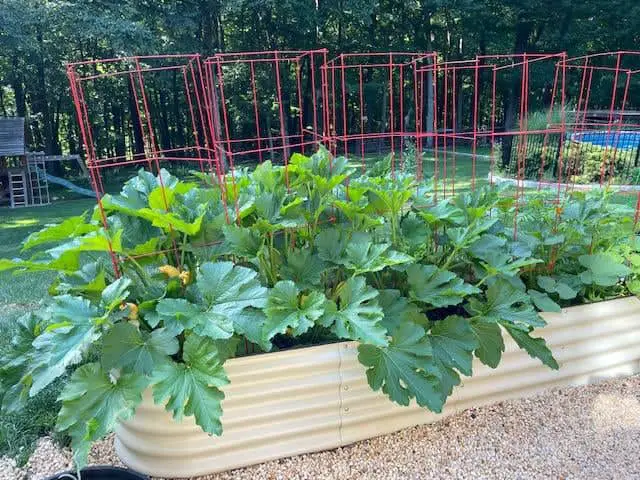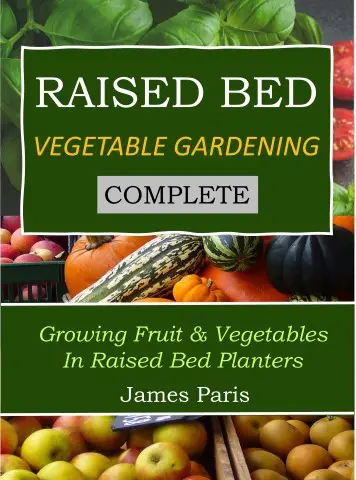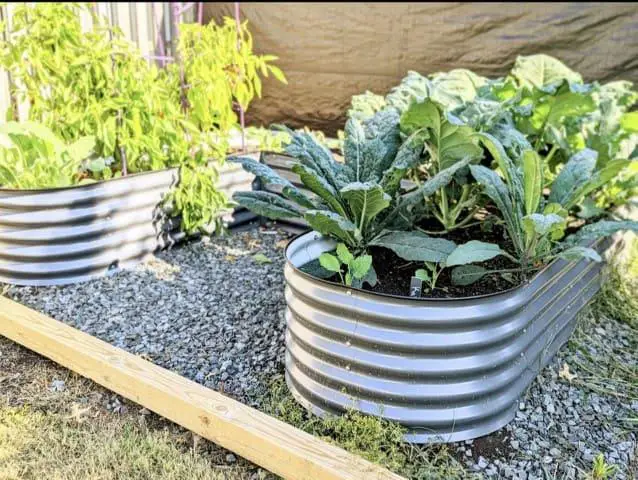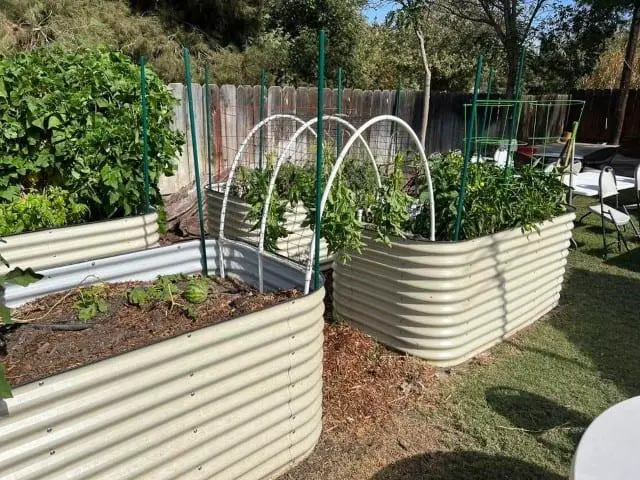Growing vegetables in Raised Beds is an efficient and simple way to start your own vegetable garden. Why do I say this? The answer is simple – and yet long winded!
Suffice it to say that with the cost of food in the stores going through the roof, the ability to grow your own vegetables is becoming increasingly necessary for those of us on a limited budget.
But what if you have very little space to spare. Or perhaps little knowledge on how to start your own vegetable garden?
This short post should answer at least some of the questions and concerns that the newcomer to vegetable growing may have.
The beauty of raised bed gardening is that it is uniquely designed for many different growing conditions and individual needs. Even where space is limited or indeed health concerns must be taken into account – there are Raised Bed options to suit virtually every scenario.
- Little room to spare? A single bed only 4 foot by 4 foot can provide a small family with vegetable throughout the growing season – if prepared properly! And a bed 8 foot long and 4 foot wide will give even more options for variety and crop size.
- Health/mobility issues? Then a Raised bed can be built say 30 inches high, that will allow access direct from a wheelchair or mobility scooter. Keeping the bed less than 3 foot wide will improve access from either side into the centre of the bed.
- Don’t like weeding? That’s no problem. The proper infill mix will ensure that you have minimum weeding to carry out – and NO NEED for expensive gardening tools!
Raised Beds come in all shapes and sizes including circular, square and rectangular – there are even Raised Beds built to create a ‘Keyhole Garden’ effect.
Raised Beds are more efficient and easier to operate than traditional ‘row’ gardening because…
- The special soil mix means that there is little to no weeding involved.
- No costly heavy tools needed, only light hand tools are used when employing a proper mix.
- Nutrient rich soil and not having to compete with garden weeds means healthier plants – more productivity.
So with all that said, here is a list of 6 top tips and tricks for beginners to get the best out of your vegetable gardening efforts.
Tip 1: Choose the Bed Infill Depth.
Consider the vegetables you would like to grow, make sure they are also ones you like to eat because, unless you want to barter with another gardener for example, it is no use growing vegetables that you do not eat! An obvious fact maybe – but I had to mention it.
Why is this important? Consider this. If you would like to grow deep tap-root vegetables like some carrots and parsnips for example, then you will need a Raised Bed deep enough to accommodate the deep roots. A shallow depth will mean that the roots will not develop as they should.
In this example then a depth of 18 inches (45cm) to 24 inches (60cm) would be advised – even deeper for some varieties.
If on the other hand you are growing vegetables that only have a shallow root base and are more ‘uptop’ like cabbage, cauliflower, broccoli, beets, lettuce, onions, leeks, peppers, tomatoes etc. Then a shallow bed from 6 inches (15cm) upwards, is all that is required. (More on this later).
Tip 2: Steel Raised Beds.

 ‘ is steel coated with a zinc-aluminium-magnesium alloy, and will last many years longer than even the galvanized steel beds
‘ is steel coated with a zinc-aluminium-magnesium alloy, and will last many years longer than even the galvanized steel bedsGalvanized steel or other treated metal beds are ideal for beginner gardeners. They come in modular form mainly (for easy transportation), and they will easily last for 25 years or longer with the better quality Garden Beds.
With the Vegega garden beds for example, they come pre-coated in a zinc-aluminum-magnesium alloy coated steel. This type will out-last the traditional galvanized metal by many years.
The argument around metal or steel Beds is mainly that they are more expensive than the cheaper timber options – and this is indeed so. However, this cost is lessoned considerably when you consider the lifetime of the metal vs the much shorter lifetime of the timber beds.
Check this post on more comparisons between metal and timber Raised Beds.
Tip 3: Filling A Raised Bed
First thing to take into account is that a ‘proper’ Infill for these Raised Beds (metal or wood) is NOT just local topsoil. Sure, it can be done. However if you want to get the very best results then you have to have a nice loose, friable, nutrient-rich, infill.
The problem with filling up the Bed with just soil, is that apart from the weeds seeds you will inevitably bring in, the soil will become compact over time.
This is especially so if you have a rich clay content in the soil. This is bad for several reasons. Firstly it means you will have more weeds to contend with. Secondly the soil is no longer easily turned over or worked. Thirdly the vegetable plants will not prosper as they should do in a properly organised area.
As a general guide, a proper mix should contain around 1/3rd compost . 1/3rd topsoil, and another 1/3rd vermiculite
. 1/3rd topsoil, and another 1/3rd vermiculite or ‘perlite’. This is not an ‘exact science’ but will give a good growing base for most vegetables.
or ‘perlite’. This is not an ‘exact science’ but will give a good growing base for most vegetables.
For deep tap-root vegetables that require free drainage, then the addition of some cheap builders sharp sand will improve conditions for them.
More details on infill mixes can be found in this post.
Tip 4: Coping with deep beds:
Apart from growing deep tap-root veggies, deep or high Raised Beds can be used for a couple of reasons. The first is for accessibility. It lessons back-ache if you are not bending over all the time to maintain your vegetables! Also for wheelchair users it is easier to access an area that is level with the sitting position of your chair.
So what if you are NOT growing deep rooted vegetables – do you still need to fill the Bed with expensive infill?
Absolutely not! If you are growing shallow rooted vegetables then you can fill up the bed to within 6 inches or more with a variety of materials including waste timber or branches similar to the way that a Hugelkultur is built. More on this here…
Tip 5: Beginner vegetables to grow
If you are growing vegetables for the first time, then it is important not to ‘over-reach’ yourself if you are to avoid disappointment.
Stick to simple plants to begin with and you will be pleasantly surprised with your efforts. Vegetables like salad leaves, lettuce, onions, and carrots, along with cabbage, broccoli, leeks, radish, cucumber, zucchini, peas and beans are all highly nutritious and easy to grow.
Beware of over-watering! More plants are killed by overwatering than by under. A simple rule is to sink your index finger into the soil to the first knuckle. If the finger comes out clean and dry then it most likely needs some water.
Tip 6: Positioning the garden
As a general rule. Most plants need at least 6-8 hours of direct sunshine to prosper, so make sure the area you choose is sufficiently sunny for your plants.
Some shade is ok – even preferable in many instances, but try to avoid positioning your bed beneath mature tree canopy. This may not only shade your plants too much, but can result in insect and fungus infestation dropping down from the foliage above.
Conclusion:
Raised Bed Gardens, whether steel, timber or even brick, are all highly effective ways to grow vegetables for beginners. The important thing is to get the infill material right, provide enough water and tend your plants regularly.
Happy planting!




